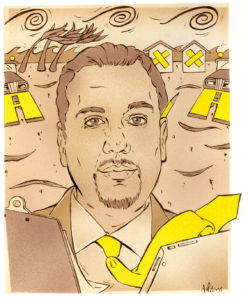Michael Kulich, the overall winner of CAI’s 2018 Outstanding Homeowner Leader award, went above and beyond to help the Turtle Creek Homeowners Association in Orlando, Fla., deal with Hurricane Irma’s destruction. As president of Turtle Creek when the storm struck, Kulich led efforts to develop and implement the community’s disaster plan, and during Irma, he turned his home into a “war room” to give board members and vendors a space to provide the community with updates and review action plans.
When the skies cleared, Kulich—a management consultant by trade—took time off from his day job to coordinate vendor activities and lead the cleanup until the community was back on its feet.
What should homeowners do before and after a hurricane?
Residents should stock up on critical supplies and identify how to stay connected to the police and the association. It’s equally important for residents to be patient after the storm passes. Turtle Creek residents were eager to begin the cleanup process after Irma. While their intentions were good, it’s better to pause, confirm everyone is safe, and confirm it’s safe to begin clearing debris.

Michael Kulich
What must a community disaster plan include?
Our plan focused on preparing our infrastructure and homeowners for potential damage and partnering with local vendors and government officials to establish communications lines for continuous updates. Between computers and cell phones, Turtle Creek board members were in constant communication with local government officials, local law enforcement, and utility companies. This approach allowed us to gather pictures of the damage and have video conferences with our landscaping vendor to develop a cleanup plan. We were back to normal operations within a couple of weeks as opposed to months.
What makes a community leader effective?
Communication is an essential quality. As a board member, I use MailChimp for email updates, Twitter, and I recently launched a YouTube channel to livestream our board meetings. Residents appreciate our efforts to keep them informed, as it lends itself to another trait of a successful community leader: transparency. Operating an association board shouldn’t be a mystery. Residents should feel welcome to attend all activities, and feedback should be encouraged.
Why do you volunteer?
Volunteering gives me an opportunity to remove myself from the daily grind and focus my time and energy helping someone else. Since high school, I’ve made it a priority to find a cause or an organization where I can volunteer.
What do you enjoy about serving on your board?
As president, I find the ability to address a homeowner’s concern and find a resolution extremely rewarding. But my main source of enjoyment stems from the relationships I’ve built with our homeowners and local vendors.
What else do you enjoy?
Traveling with my wife and daughter and adding to my sports card collection. Lately, my free time is spent writing. I’m creating my first blog, which focuses on community association topics and trends.
April is National Volunteer Month. Read our articles about preparing for a volunteer role and five steps for effective community leadership. And you can read about the inspiring work done by a homeowner leader who put his community toward a path of financial stability.
The post Crisis communicator: A board president’s coordinated strategy during Hurricane Irma appeared first on Ungated: Community Associations Institute Blog.
